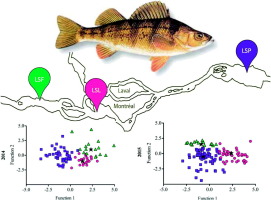Science of the Total Environment ( IF 9.8 ) Pub Date : 2020-04-08 , DOI: 10.1016/j.scitotenv.2020.138515 C Landry 1 , M Houde 2 , P Brodeur 3 , M Boily 1

|
Since the mid-1990s, the decline of the yellow perch population of Lake Saint-Pierre (hereinafter LSP) in Quebec, Canada has been the subject of several research programs. The combined effect of habitat deterioration, the presence of invasive species, and poor water quality negatively affected the yellow perch population in this lake. In 2013, we sampled yellow perch (larvae, juveniles and adults) at six sites along the St. Lawrence River representing a gradient of increasing human influences from upstream to downstream and measured several biomarkers including retinoid compounds (vitamin A). In the most contaminated sites (LSP, north and south shores), we found that retinoid stores were decreased in all three stages of development. To corroborate these results and to test other biomarkers, we once again sampled yellow perch (adults only) from the same sites. Results from our 2014 and 2015 samplings confirmed that LSP yellow perch appeared to be at a disadvantage compared to fish from upstream populations. Individuals from LSP have lower acetylcholinesterase (AChE) activity as well as lower retinoid levels in liver and plasma. These fish were also marked by lower levels of antioxidants such as lycopene and vitamin E. A discriminant analysis of this set of results confirmed that the yellow perch of the LSP could be easily discriminated from those of the other sites (2014 and 2015) on the basis of liver retinoid and, to a lesser extent, of the liver tocopherol and protein concentration of the muscle, as well as AChE activity and DROH (all-trans-3,4-dehydroretinol) measured in plasma.
中文翻译:

生物标记物可建立圣劳伦斯河黄鲈(Perca flavescens)健康状况与人为干扰梯度之间的关系。
自1990年代中期以来,加拿大魁北克省圣皮埃尔湖(以下简称LSP)的黄鲈种群的减少一直是若干研究计划的主题。生境恶化,入侵物种的存在以及水质差的综合影响对该湖的黄鲈种群产生了负面影响。2013年,我们在圣劳伦斯河沿岸的六个地点取样了黄色鲈鱼(幼虫,幼鱼和成年鱼),代表了从上游到下游人类影响力的梯度增加,并测量了包括类维生素A化合物(维生素A)在内的几种生物标志物。在受污染最严重的地区(LSP,北岸和南岸),我们发现类维生素A储存在所有三个开发阶段均减少。为了证实这些结果并测试其他生物标志物,我们再次从同一地点采样了黄色鲈鱼(仅限成人)。我们2014年和2015年采样的结果证实,与上游种群的鱼类相比,LSP黄鲈似乎处于劣势。LSP患者的乙酰胆碱酯酶(AChE)活性较低,肝脏和血浆中的类维生素A水平较低。这些鱼还具有较低的抗氧化剂水平,例如番茄红素和维生素E。对这些结果的判别分析证实,可以很容易地将LSP的黄色鲈鱼与其他地点(2014年和2015年)的鲈鱼区分开。类视黄醇的基础,在较小程度上还包括肝脏的生育酚和肌肉的蛋白质浓度,以及AChE活性和DROH(全 我们2014年和2015年抽样的结果证实,与上游种群的鱼类相比,LSP黄鲈似乎处于劣势。LSP患者的乙酰胆碱酯酶(AChE)活性较低,肝脏和血浆中的类维生素A水平较低。这些鱼还具有较低的抗氧化剂水平,例如番茄红素和维生素E。对此结果的判别分析证实,可以很容易地将LSP的黄色鲈鱼与其他地点(2014年和2015年)的鲈鱼区分开。类视黄醇的基础,在较小程度上还包括肝脏的生育酚和肌肉的蛋白质浓度,以及AChE活性和DROH(全 我们2014年和2015年采样的结果证实,与上游种群的鱼类相比,LSP黄鲈似乎处于劣势。LSP患者的乙酰胆碱酯酶(AChE)活性较低,肝脏和血浆中的类维生素A水平较低。这些鱼还具有较低的抗氧化剂水平,例如番茄红素和维生素E。对这些结果的判别分析证实,可以很容易地将LSP的黄色鲈鱼与其他地点(2014年和2015年)的鲈鱼区分开。类视黄醇的基础,在较小程度上还包括肝脏的生育酚和肌肉的蛋白质浓度,以及AChE活性和DROH(全 LSP患者的乙酰胆碱酯酶(AChE)活性较低,肝脏和血浆中的类维生素A水平较低。这些鱼还具有较低的抗氧化剂水平,例如番茄红素和维生素E。对这些结果的判别分析证实,可以很容易地将LSP的黄色鲈鱼与其他地点(2014年和2015年)的鲈鱼区分开。类视黄醇的基础,在较小程度上还包括肝脏的生育酚和肌肉的蛋白质浓度,以及AChE活性和DROH(全 LSP患者的乙酰胆碱酯酶(AChE)活性较低,肝脏和血浆中的类维生素A水平较低。这些鱼还具有较低的抗氧化剂水平,例如番茄红素和维生素E。对这些结果的判别分析证实,可以很容易地将LSP的黄色鲈鱼与其他地点(2014年和2015年)的鲈鱼区分开。类视黄醇的基础,在较小程度上还包括肝脏的生育酚和肌肉的蛋白质浓度,以及AChE活性和DROH(全反式-3,4-脱氢视黄醇)的血浆。



























 京公网安备 11010802027423号
京公网安备 11010802027423号